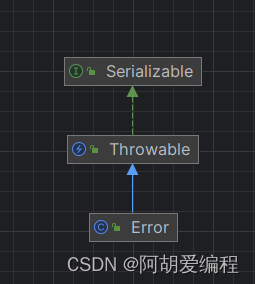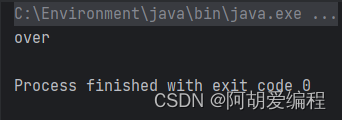文章目录
- 异常
- 异常处理
- 自定义异常
异常
指的是程序在执行过程中,出现的非正常的情况,最终会导致JVM的非正常停止。Java处 理异常的方式是中断处理。
- 异常体系
异常的根类是 java.lang.Throwable,,其下有两个子类:java.lang.Error 与 java.lang.Exception。


- 异常分类
编译时期异常:checked异常。在编译时期,就会检查,如果没有处理异常,则编译失败。(如日期格式化异常)运行时期异常:runtime异常。在运行时期,检查异常.在编译时期,运行异常不会编译器检测(不报错)。(如数学异常)

异常处理
Java异常处理的五个关键字:try、catch、finally、throw、throws
- 抛出异常throw
使用格式:
throw new 异常类名(参数);
public class ExceptionDemo {public static int getElement(int[] arr , int index){if (index < 0 || index >= arr.length){throw new ArrayIndexOutOfBoundsException("数组下标越界啦!");}int element = arr[index];return element;}public static void main(String[] args) {int[] arr = {1, 2, 3, 4, 5};int index = 5;int element = getElement(arr, index);System.out.println(element);System.out.println("over");}
}

- 声明异常throws
使用格式:
修饰符 返回值类型 方法名(参数) throws 异常类名1,异常类名2…{ }
import java.io.FileNotFoundException;
import java.io.IOException;public class ExceptionDemo {public static void findFile(String file) throws FileNotFoundException,IOException{if (!file.equals("a.txt")){throw new FileNotFoundException("找不到文件");}int index = file.lastIndexOf(".");String prefix = file.substring(index);if (prefix.equals(".txt")){System.out.println("文件格式正确");}else {throw new IOException("文件格式不正确");}}public static void main(String[] args) throws IOException {String file = "a.txt";findFile(file);System.out.println("over");}
}

- 捕获异常try…catch
Java中对异常有针对性的语句进行捕获,可以对出现的异常进行指定方式的处理。
try{编写可能会出现异常的代码
}catch(异常类型 e){处理异常的代码//记录日志/打印异常信息/继续抛出异常
}
- 该方法不处理,而是声明抛出,由该方法的调用者来处理(throws)。
- 在方法中使用try-catch的语句块来处理异常。
import java.io.IOException;public class ExceptionDemo {public static void findFile(String file) throws IOException{int index = file.lastIndexOf(".");String prefix = file.substring(index);if (prefix.equals(".txt")){System.out.println("文件格式正确");}else {throw new IOException("文件格式不正确");}}public static void main(String[] args){String file = "a.html";try {findFile(file);} catch (IOException e) {e.printStackTrace();System.out.println(e.getMessage());}System.out.println("over");}
}

Throwable类中定义了一些查看方法:
- public String getMessage() :获取异常的描述信息,原因(提示给用户的时候,就提示错误原因。
- public String toString() :获取异常的类型和异常描述信息(不用)。
- public void printStackTrace() :打印异常的跟踪栈信息并输出到控制台。
- finally 代码块
有一些特定的代码无论异常是否发生,都需要执行。因此我们就会使用finally关键字来解决这个问题
import java.io.IOException;public class ExceptionDemo {public static void findFile(String file) throws IOException{int index = file.lastIndexOf(".");String prefix = file.substring(index);if (prefix.equals(".txt")){System.out.println("文件格式正确");}else {throw new IOException("文件格式不正确");}}public static void main(String[] args){String file = "a.html";try {findFile(file);} catch (IOException e) {e.printStackTrace();System.out.println(e.getMessage());} finally {System.out.println("不管出不出现异常都要执行!");}System.out.println("over");}
}

- 多个异常进行捕获的方式:
- 多个异常分别处理。
- 多个异常一次捕获,多次处理。
- 多个异常一次捕获一次处理。
注意:
- 运行时异常被抛出可以不处理。即不捕获也不声明抛出。
- 如果finally有return语句,永远返回finally中的结果,避免该情况.
- 如果父类抛出了多个异常,子类重写父类方法时,抛出和父类相同的异常或者是父类异常的子类或者不抛出异常。
- 父类方法没有抛出异常,子类重写父类该方法时也不可抛出异常。此时子类产生该异常,只能捕获处理,不能声明抛出
自定义异常
异常类如何定义:
- 自定义一个编译期异常: 自定义类 并继承于 java.lang.Exception 。
代码示例:
// 业务逻辑异常
public class MyException extends Exception {/*** 空参构造*/public MyException () {}/**** @param message 表示异常提示*/public MyException (String message) {super(message);}
}
- 自定义一个运行时期的异常类:自定义类 并继承于 java.lang.RuntimeException 。
public class MyException extends RuntimeException {/*** 空参构造*/public MyException () {}/**** @param message 表示异常提示*/public MyException (String message) {super(message);}
}
总的来说就是,继承异常类Exception或者RuntimeException,重写空参构造方法和有参构造方法。
欢迎java热爱者了解文章,作者将会持续更新中,期待各位友友的关注和收藏。。。




)

)



)

)


)
DroneCAN 适配器节点(二))


